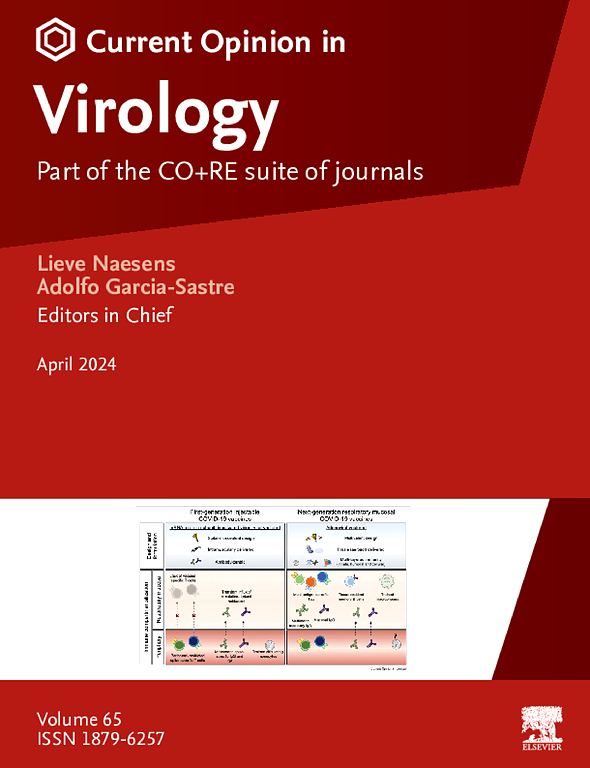Host-targeted antivirals as broad-spectrum inhibitors of respiratory viruses
IF 5.1
2区 医学
Q1 VIROLOGY
引用次数: 0
Abstract
Respiratory viruses, including influenza virus, respiratory syncytial virus, human rhinovirus, and severe acute respiratory syndrome coronavirus 2, are among the leading causes of acute respiratory infections worldwide. Strategies for antiviral drug development include direct-acting antivirals (DAAs), which inhibit viral proteins, or host-targeting antivirals (HTAs), which target host factors required for the viral life cycle. DAAs are often virus-specific, leaving gaps for emerging viruses such as novel coronaviruses and influenza viruses, or less common respiratory viruses such as human metapneumovirus. Moreover, DAAs are prone to viral resistance due to the low fidelity of viral polymerases, whereas HTAs act on conserved host proteins that are less susceptible to viral escape due to greater genetic stability. A variety of HTAs are currently being investigated that target viral entry, replication, assembly, or egress. The key challenges for the development of effective broad-spectrum HTAs are related to safety and translation of in vitro potency to in vivo efficacy. This review examines host factors crucial for respiratory virus lifecycles — including sialic acid receptors, lipids, phosphoinositide kinases, mitogen-activated protein kinases, cellular helicases, and nucleotide biosynthesis pathways — and the small-molecule inhibitors and biologics that are being explored to target them.
宿主靶向抗病毒药物作为呼吸道病毒的广谱抑制剂。
呼吸道病毒,包括流感病毒、呼吸道合胞病毒、人鼻病毒和严重急性呼吸道综合征冠状病毒,是全世界急性呼吸道感染的主要原因之一。抗病毒药物开发的策略包括直接作用抗病毒药物(DAAs),其抑制病毒蛋白,或宿主靶向抗病毒药物(hta),其靶向病毒生命周期所需的宿主因子。daa通常是病毒特异性的,这为新出现的病毒(如新型冠状病毒和流感病毒)或不太常见的呼吸道病毒(如人偏肺病毒)留下了空白。此外,由于病毒聚合酶的保真度较低,DAAs容易产生病毒抗性,而hta作用于保守的宿主蛋白,由于遗传稳定性更高,这些蛋白对病毒逃逸不太敏感。目前正在研究针对病毒进入、复制、组装或出口的各种hta。开发有效的广谱hta的关键挑战与安全性和体外效力到体内功效的转化有关。本文综述了对呼吸道病毒生命周期至关重要的宿主因子,包括唾液酸受体、脂质、磷酸肌苷激酶、丝裂原活化蛋白激酶、细胞解旋酶和核苷酸生物合成途径,以及正在探索的针对这些因子的小分子抑制剂和生物制剂。
本文章由计算机程序翻译,如有差异,请以英文原文为准。
求助全文
约1分钟内获得全文
求助全文
来源期刊

Current opinion in virology
VIROLOGY-
CiteScore
11.80
自引率
5.10%
发文量
76
审稿时长
83 days
期刊介绍:
Current Opinion in Virology (COVIRO) is a systematic review journal that aims to provide specialists with a unique and educational platform to keep up to date with the expanding volume of information published in the field of virology. It publishes 6 issues per year covering the following 11 sections, each of which is reviewed once a year: Emerging viruses: interspecies transmission; Viral immunology; Viral pathogenesis; Preventive and therapeutic vaccines; Antiviral strategies; Virus structure and expression; Animal models for viral diseases; Engineering for viral resistance; Viruses and cancer; Virus vector interactions. There is also a section that changes every year to reflect hot topics in the field.
 求助内容:
求助内容: 应助结果提醒方式:
应助结果提醒方式:


